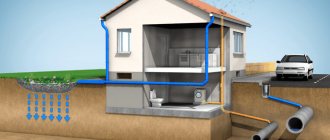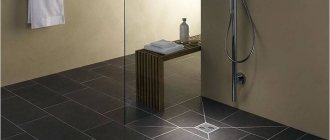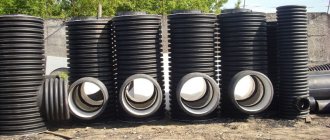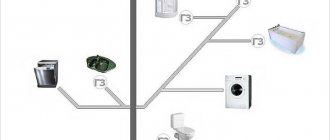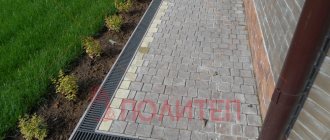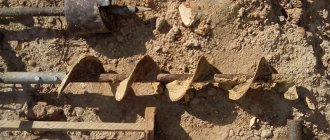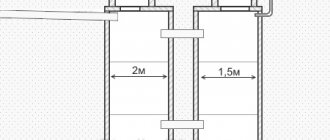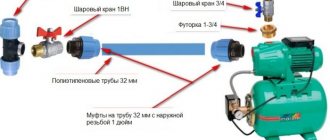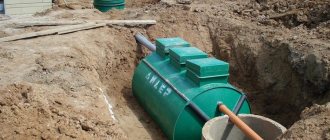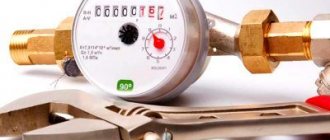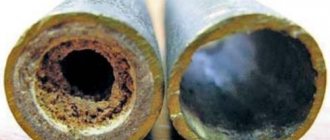This article covers in detail the question - how to correctly replace or install a water meter yourself, installation diagrams, how to choose a water meter, what tools and documents will be needed, etc.
Under the current conditions, the time for standardized water consumption has not yet arrived, but the first step towards this is to record its consumption using water meters.
Installing a water meter these days is required by Federal law (penalties are applied to force the population to install it), and in order for it to work correctly, a standard diagram for connecting a water meter in an apartment has been developed.
Is it possible to install water meters in an apartment or private house yourself?
The law does not prohibit installation work on installing hot and cold water meters yourself.
On July 1, 2013, Federal Law No. 261 on the mandatory universal installation of water meters came into force.
If the average person decides not to involve craftsmen, there is an opportunity and desire, then there is no clear wording of the prohibition in this Resolution.
There are certain nuances, the observance of which will protect the private owner from mistakes and troubles:
- The purchase of metering devices is carried out only in specialized companies that have a license. Each meter must have a technical passport.
- The quality of installation work is checked by Vodokanal services or special organizations authorized to verify metering meters.
- On the day of installation, a necessary condition is to turn off the water supply through the riser on all floors of the building, agreed with the residents and the building manager of the high-rise building;
- After installing the devices, all possible problems (malfunction, leakage) are resolved and compensated at the expense of the apartment owner.
If the above conditions are not met, the water utility has the right:
- do not allow water meter registration;
- if there is a risk of an emergency, dismantle;
- fine the unauthorized installer.
Important! When installing hot and cold water meters without skills, it is better to use professional repair and maintenance services.
To avoid unpleasant moments, neighbors are warned in advance about temporary inconveniences when the water is turned off.
Briefly about the main thing
The law determines that water meters must be installed at all facilities, regardless of their purpose.
There are several types of water meters, and they are divided according to the bore diameter, the number of channels inside, and the type of counting mechanism: mechanical and electronic. The latter are the meter itself and the remote panel connected by cable.
Manufacturers offer dry and wet meters. In the first, the counting mechanism is located in a sealed chamber and does not come into contact with water. In the second, this mechanism comes into contact with water.
Water meters are produced in two classes: “A” – with an error of ±1%, “B” – ±2%.
Installation is carried out in a well on the street so that water utility representatives can freely take readings.
The water meter unit consists of the meter itself, two shut-off valves, a strainer and a check valve.
Ratings 0
Pros and cons of self-installation
The advantages of self-installation are obvious:
- saving money on installation of devices;
- the ability to determine the date and time of installation at a convenient time for the owner of the apartment or house;
- independent choice of metering meter model based on ratings and reviews.
Disadvantages of DIY installation:
- risk of poor-quality installation of metering devices;
- increasing the likelihood of an emergency (especially in an apartment building);
- double costs associated with forced dismantling and re-installation of metering devices.
The owner must make a conscious decision: calculate the pros and cons of “home” installation of a water meter for hot and cold water consumption.
Legal subtleties and practical solutions
The interpretation of the meaning of the act implies that the owners of the premises are obliged to ensure that the resources supplied by the relevant organizations are accounted for. This means that a consensus must be reached between the supplier and the consumer on the procedure for accounting for resources and the equipment used. The accounting procedure is ensured by the integrity of the device, that is, the meter, which is sealed by a representative of the organization supplying water. In general, this is a management or housing and communal services office.
Sectional view of a water meter.
Measuring equipment approved for installation for metering water consumption is entered into the database of the Federal Information Fund for Ensuring the Uniformity of Measurements and is available for review at fundmetrology.ru. The passport of the purchased measuring device must indicate the registration number of this type of equipment in the Information Fund database. Additional testing or inspection of the purchased device is not required, but in order to avoid unnecessary misunderstandings, this issue should be previously agreed upon with the operating organization.
Meters may not be installed if the building is considered dilapidated and there are relevant documents stating this situation. A building with a significant degree of wear and tear has communications in appropriate condition.
It is simply dangerous to install any equipment on them. It should be added that the refusal of the homeowner to install water meters is not a punishable action. In this case, payment is provided at an increasing rate, but no administrative or punitive sanctions are expected.
Installation elements of the system.
When installing a water meter in an apartment or house, two related procedures arise, which can be performed separately or simultaneously, depending on prevailing local characteristics and practices. The first procedure is the installation of equipment on the water supply system.
The owner of the premises can do it himself or involve specialists, including those associated with the operational office that supplies drinking water to his apartment or house. This does not violate the rules and procedure for installing water meters in the apartment. The work is carried out at the expense of the owner of the premises.
The second procedure is the acceptance of devices into operation by the management organization, which will receive money for the resources received, based on the readings of installed measuring instruments. Sealing of meters and, if necessary, other elements of the system is carried out by a representative of the management office. The procedure should be performed by them free of charge.
If the installation of the measuring equipment is carried out by a company authorized by the resource supplier to accept it into operation, both procedures can be completed in one stage.
Principles for choosing a metering device
In order not to make a mistake before purchasing a water meter, you need to take into account the accuracy class of the device . The accuracy of water flow measurements depends on it, but the cost of the water meter will be higher.
Which one should I buy for DHW?
When purchasing a device for domestic hot water, most often the choice is made on tachometer devices.
Turbine models are used for pipelines with a diameter of 50 to 200 mm. For narrower sections (up to 40 mm), vane meters are used.
We advise you to adhere to the following features:
- pressure in the device is from 16 atmospheres or more;
- operating heating temperature range from 5 to 150 degrees Celsius;
- maximum sensitivity is equal to the average hourly passage of a volume of water;
- The permissible error should not exceed 5%.
On a note! The metering device must bear the manufacturer's seal. The technical passport contains the device number, test date and QC stamp. The seller adds information about the date of sale and the seal of the seller-store to the details.
ITELMA WFW20.D110
In terms of reliability and technical characteristics of mechanical meters, ITELMA WFW20.D110 (a joint German-Russian brand) is in 1st place.
Advantages:
- 6 year warranty;
- affordability.
"DecastMetronic" VSKM 90-15 DG
The vane water meter is convenient for main pipelines with low energy consumption.
Advantages:
- 10 year warranty;
- easy to repair;
- simple design.
The main disadvantage is that there is no mounting hardware for installation.
Zenner ETWI-N DN 15
The German model is one of the best mechanical universal water meters. The device uses a multi-jet operating principle.
Advantages:
- high build quality;
- accuracy of flow measurement;
- there is a function for transmitting values via Wi-Fi;
- long term - 12 years.
The only drawback is the price is higher than average for water meters.
It is recommended to take into account individual characteristics:
- what is the state of communications;
- approximate composition of water (hard or soft);
- availability of funds for purchase;
- indicators of heating water entering the system.
To assess financial capabilities, it is better to check with special organizations the approximate cost of installing equipment. Installing a water meter on your own is a troublesome and responsible undertaking.
Which one to buy for cold water supply?
Main characteristics of the cold water meter: temperature range up to 30 degrees Celsius. A distinctive feature from the GW device is the calibration interval. The difference will be in the timing of verification; usually a hot water meter requires more frequent verification.
For a water meter for cold water, the interval is 6 years, for hot water - from 4 to 6. High temperatures wear out the meter parts faster.
The color of the housing differs; for cold water, blue ones are often used; for hot water, a red meter is required. The diameter of the pipeline is taken into account, options are possible from the minimum (15 mm) to the maximum - 20 mm.
Important! When installing a water meter, the following rule is followed: a meter designed to measure the flow of cold liquid is placed on a cold pipe. It cannot be used for hot water!
Betar SHV15
In terms of operational capabilities for cold water, the Russian Betar SKHV15 meter is distinguished. There are three installation options: vertical, horizontal or at an angle. Permissible liquid temperature +5….+40 degrees Celsius, maximum pressure 10 Bar.
Advantages:
- with warranty 6, the service life can reach 18 years;
- low cost;
- convenient to install and operate.
NORM SVKM-25X
More expensive in price, but optimal in performance. It deservedly ranks 1st among premium models.
Advantages:
- brass body with anti-corrosion coating;
- compact, easy to install;
- there is magnetic protection against interference with the operation of the device;
- pulse output.
Practice shows that it is better to choose tachometer models for an apartment or private household .
They have an optimal balance of cost, quality, and ease of use.
Which counter to install
Now to the question of choosing a water meter for a private home. Of course, everything will depend on the size of the house, the number of water consumers in it, and the number of people living in the house. The greater the number of all three criteria at once, the larger the diameter of the pipe should enter the house, the more powerful the meter will have to be installed.
Tachometer water meter
The simplest and cheapest are mechanical water flow meters. Their design includes an impeller located in a channel through which water flows. The counting mechanism counts the number of revolutions of the impeller, which directly depends on the volume of flowing liquid. There are more complex flow meters that operate from an electric current network. They are called volatile. This category includes vortex, electromagnetic, and ultrasonic models.
There is a division of devices according to the location of the counting mechanism. It can be located together with the impeller inside the drainage channel. Such devices are called wet. The mechanism can also be located in a separate compartment where water does not enter. Such a device is called dry.
It is clear, and purely structurally, all meters are very different from each other. For example, in vortex models, some body of a specific shape is installed inside the flow channel, which provides the intensity and shape of the vortex. So the frequency of turbulence is directly proportional to the speed of the water flow.
Therefore, based on the requirements of the water supply network, you can install any of the water meters offered by manufacturers. The main thing is that it works correctly and shows the exact volume of water consumed. Of course, the price side of the choice is an important criterion. As mentioned above, mechanical tachometer water meters with an impeller or turbine are the cheapest.
Attention! It should be noted that a water pipe with a diameter of at least 40 mm is usually installed into a private house, so multi-channel tachometer meters are installed on a pipe of 40-50 mm, turbine meters on pipelines with a diameter of 50-500 mm.
Electromagnetic water meters
Differences in mounting DHW and cold water devices
It is permissible to install a DHW meter on a cold pipe; in other words, it is permissible to install two red ones for hot and cold water.
Note the advice of practitioners! You can install both red meters, but for convenience it is better to separate them so that there is no confusion when collecting readings.
There are houses in which the hot water supply system operates according to a two-pipe system. To install a water meter on a hot water supply, you need a bypass valve. Otherwise, the meter will count excess water consumption.
For cold water meters, rubber gaskets are installed; for domestic hot water, the private owner must buy paronite gaskets.
Install water meters - yourself or through a company
Many users are afraid to do the installation themselves. There is a prejudice that such a procedure is illegal.
However, in reality, only residents decide whether to do the work themselves or turn to professionals.
In the first case, you will need to have some tools and figure out the water supply system, but this will save money. When choosing the second option, the user will face financial costs, but he will save his own effort and time.
How to install correctly: step-by-step instructions
Before starting installation work, the private owner needs to write an application to the local Vodokanal office.
After receiving the technical specifications for the water meter, a model is selected and an metering device is purchased. They check the presence of the certificate and seal impressions.
It is necessary to have water meters checked by the Vodokanal management, private licensed companies or the Housing Office.
The meter is left with a technical passport, in which, upon successful verification, all fields are filled in and the organization’s stamp is affixed. Indicate the day of the upcoming seal on the device after installation is completed.
The meter has an instrumentation - seal. Its safety is a guarantee that the water meter will be accepted by Vodokanal. There are situations when the plant seal is broken, the water meter will be taken to the instrumentation, but without the latter’s seal the indicator data will not be taken into account for calculation.
The principles of installing a water meter in a private house and apartment are largely similar. Let's look at them.
Mounting kit
To install the device you need the following parts:
- Stopcock. Brass ball ones are more often used, if the pipeline is made of propylene, a plastic tap is installed. It must be new and of high quality to eliminate the risk of failure. The private owner must control the position of the shut-off valve. Two positions are allowed: “open”, “closed”. If it is not fully opened, it will quickly wear out and fail.
- Water purification filter with a mesh for large contaminants. There are two types - right angle and oblique. Periodically, the mesh needs to be cleaned of accumulated dirt.
- Check valve. So that the device does not start to “wind” back in a situation where the water supply to the system has stopped.
- Water meter.
For installation, the private owner independently purchases a check valve for each pipeline. To make the connection airtight, sealing materials are needed.
It is more convenient to use TangitUnilok threads with lubricant made from silicone, paste, or flax, tow. Connecting elements - fittings - will be required to make the transition from metal to metal-plastic.
Special tools required:
- scissors for cutting pipes made of metal or polypropylene,
- “iron” for welding joints and a set of keys.
If work is carried out with metal pipes, you need a grinder and equipment for cutting threads.
How to determine the location?
There are general rules for choosing a location:
As close as possible to the point of pipe entry from the main. The site is chosen horizontal to prevent water intake past the device. The place of attachment is determined so that the inspection services do not have unnecessary suspicions.- In an apartment, a meter is often installed near the toilet; if pipes pass inside the floor structure, the water meter is mounted in the bathroom.
- For private housing construction, the water meter is installed near the outer wall at a distance of no more than 200 mm from the exit point of the pipeline.
- If there is a well in the area with a pipe leading out from the main, a major installation is carried out. The well is covered with a lid (metal) and sealed. Unsealing is possible in case of fire or emergency. In other options, the seal is removed only in the presence of an official from the Vodokanal.
The water meter will be able to give correct readings if the risk of turbulence flows is reduced. Before the counter 45 mm, after - 15 mm. It is mandatory to install a valve in front of the metering device to shut off the water supply.
Installing a water meter
After purchasing all the necessary parts and components, proceed directly to installing the water meter.
The installation procedure includes:
- It will be easier if all the parts are lined up in one line , starting from the check valve and ending the chain with a shut-off valve. The manufacturer provides arrows, check that their direction is the same.
- It is recommended to make a “dry” connection in order to calculate the number of turns in advance. Usually there should be up to 5 pieces. During installation, remember the position of each element. Then they unwind it, take the sealing material, and wind it onto the faucet filter with the required number of turns. The sealant is placed so as to cover the entire thread.
- Shutting off the water supply . It is necessary to completely turn off the liquid supply through the main water supply. If it is not possible to close the outlet from the riser, it is necessary to block the flow of media through the cold and hot water risers.
- After completing the connection of all elements, insertion is carried out . For an apartment building, you need to call an inspector from Vodokanal in advance. The installer measures the length of the structure. An equal distance is cut off on the pipe; it is better to place a water container at the bottom.
- Fastening the structure to the pipe. If the pipe is made of metal, you need a thread and a clear measurement of the length to cut the excess section. It is easier to mount the meter on polypropylene pipes. Additionally, fittings are required to make connections between different materials.
Visual installation instructions can be seen in the video:
Direct installation is not so complicated and does not require time. The most difficult thing is to go through all the approvals and obtain documents for permission to install water meters.
Features of the registration procedure and delivery of water meters for registration
Before installing the meter on the water supply, approval for installation work is obtained from the Vodokanal department. Only then is it worth buying the device itself.
Parameters required for accounting before buying a meter:
- The meter series number must be the same as written in the passport.
- The seal of the device must be equipped with an imprint of the Gosstandart sign.
- The date of verification of the device at the factory is stated in the passport.
The seller, in turn, stamps the date when the device was purchased.
Attention! A good purchase option is to purchase a meter with a small interval between the dates of inspection at the factory and the day of purchase.
The device must be checked immediately:
In the housing department- To the Vodokanal department.
- To a specialized organization licensed for this type of work.
The passport is applied to the device for verification. The inspection body will put its marks on the document, including its stamp. Next, they will schedule a time to seal the device.
The seal must not be damaged, because the device will not be accepted at the Vodokanal department, since the water meter data will be invalid. If the factory seal is accidentally damaged, the device is suitable for use.
Attention! To install the device yourself, the housing department must provide a diagram with technical conditions that must be observed during installation work.
What to do after?
The final stage after installation is a mandatory performance check. To do this, perform the following steps sequentially:
- turn on the water supply;
- gradually open the ball valve;
- check if there is a leak.
If everything went without a water leak and the meter is working normally, they call a Vodokanal inspector . After the inspection, the water meter is sealed, registered and marked in the device’s data sheet.
The private owner must receive a document confirming the acceptance of the device into operation, a technical passport with a mark on the date of the seal. Calculations of meter readings are carried out from this day.
You cannot install the seal yourself or invite private craftsmen . The sealing procedure is carried out after an official application for acceptance of the device for measuring water flow.
Important! Until registration has been completed, water meter readings cannot be taken to calculate the cost of water supply services. It is better to do the procedure immediately after successful testing of the metering design.
Seal installation and technical documentation
After you have installed the metering unit and checked that it is working properly, the question arises, how to properly seal the water meter? You should find out who is doing this, whether it is possible to put a filling yourself.
You should entrust the installation of the seal to specially trained people: representatives of the water utility or the management company. To do this, you must submit an application to receive a meter.
Do not hesitate to apply, despite the installed meter, water consumption will still be determined at the maximum before official registration.
And you will be able to pay the meter only after completing the official sealing procedure. Information on how to do this correctly is described in detail in our other article.
Installing a filling is a free procedure. You shouldn’t install it yourself; you’ll still have to call a representative of the management company.
Within some time, usually from three to five days, a local government representative will be sent to respond to your application. For normal working contact with him, you must have a verification certificate and a meter passport with you.
The specialist’s responsibilities include checking the correct installation order of the water meter unit and all its components, and also checking the integrity of the unit elements.
The water utility representative does not have the right to control the qualifications of the person installing the meter.
After checking and sealing the unit (with his own seal), the inspector will draw up a commissioning report, where he will enter the initial meter readings and provide you with a service agreement.
After carefully reading the contract, making sure that you are satisfied with everything, put your signature.
It is not allowed to use data taken from the meter in utility bills if a seal is not installed or there is no polymer film with a verification stamp printed on it.
After signing the contract, you begin to pay for water according to the meter. Among the documents, the owners should have one copy of the service agreement and the act of putting the meter into operation.
It is also necessary to leave a technical passport and a certificate of verification of the water meter. An employee of the management company will need a technical passport; it is better to make a photocopy in advance.
There are times when re-filling is required. For example, the service life of the devices has expired, one of the elements of the unit has broken, or a new element has been added to the system.
Therefore, it is better to store documents separately from other papers, so that in case of an unforeseen situation they are at hand.
Preparing for installation
Experts who know how to install water meters in an apartment recommend first of all checking the package contents of the purchased device and preparing the necessary materials and tools . First of all, experts advise purchasing gaskets (rubber for cold pipelines, paronite for hot ones). You may also need plumbing tow and special sealing pastes. As an alternative, synthetic threads that already have silicone lubricant can be used.
The set of tools required largely depends on the type of pipes available. Please note that you will have to cut out a certain area, so you will need a hacksaw or an appropriate tool for plastic.
- If the pipes are metal, to install the assembled unit (meter with additional accessories), you need to cut a thread (stock up with the necessary tools).
- If the communications are made of plastic (polypropylene), purchase connecting fittings, scissors for cutting plastic pipes and a special soldering iron.
iron for polypropylene pipes
To tighten connections, you can use adjustable or spanner wrenches of the appropriate diameter; it is only important not to be overzealous and not to “tighten” the threaded connections.
When checking the completeness of the meter, you can lay out all the elements on a flat surface in the direction of the water flow:
- Shut-off valve (ball models allow you to simply shut off the flow or open the water supply, they quickly fail in an intermediate position between “open” and “closed”; a valve is required to regulate the flow). The faucet is usually not included. An existing inlet valve or faucet can be used if it is in good condition. If the service life of the existing shut-off valves is very long, it is better to change them during installation of the meter.
- A mechanical filter that retains insoluble impurities can extend the life of the device. If the filter is not included, you will need to purchase one.
A coarse water filter is installed in front of the meter - The first connecting pipe (with a union nut - American).
- The water meter itself.
- Second connecting pipe.
Meter and pipes with union nuts - Check valve , which prevents reverse rotation of the meter impeller when the water supply is turned off and air is “leaked.” You may have to buy extra if it is not included.
Important: When laying out the elements of the future meter block, pay attention to the arrows indicating the direction of the water. They should all point in the same direction.
Before installation begins, you will need to shut off the water supply. In a multi-storey building, you will have to turn off the entire riser, which can only be done by utility workers.
"Complicated" apartments
But what if the apartment has a fire hydrant or two-pipe hot water supply? Alas, in this case there is no way to set the counter yourself. This must be done either by the water utility or a licensed specialist from a contractor. *** Although installing water meters is not so much labor-intensive as it is troublesome, the savings on water fully justify it. And since water is becoming more expensive and there is no sign of any reduction in price, a water meter is definitely beneficial. When it comes to installing meters, plumbers most often accommodate subscribers halfway: accurate consumption recording makes it easier for them to report and receive bonuses for savings.
Selection criteria and verification deadlines
The simplicity of the meter design made it possible to automate the process of their assembly on an industrial scale. This contributed to the emergence of a whole host of manufacturers, and in each region of the country, in stores it is the regional players in this segment of the plumbing market that prevail. Therefore, it makes no sense to recommend any manufacturer as a leader. Often, even in neighboring regions of the Russian Federation, the assortment is presented by different companies.
But for other signs, we can give some advice.
The meters still have a gradation based on water temperature:
- Cold;
- Hot;
- Universal.
According to objective estimates of many experts, in a few years only universal models that can be installed without regard to temperature will remain on the market. But for now, the choice should start with this parameter.
Verification periods can be 4 or 6 years. This means that after a specified period of time, the meter must be calibrated. You can do this in two ways:
- Remove the meter and take it to the regulatory authorities for verification;
- Call a specialist from the regulatory authorities to your home.
In any case, you will have to pay for the service. Because according to the Decree of the Government of the Russian Federation No. 824 of September 19, 2013, the owner of the equipment must pay for the verification. The cost of services varies from region to region. At the stand of the inspection organization, such a procedure costs 300-500 rubles, when calling a specialist to your home, it costs 700-800 rubles.
If the result is satisfactory, then a mark is placed in the product passport with the date of the next verification. If not, then a corresponding entry is made in the document - “the meter is faulty.” And in fact, it turns out that you will pay to find out about the need to purchase a new meter.
Considering that the cost of a new meter starts from 700 rubles, in some cases it will be appropriate not to carry out verification, but to purchase a new device.
An important condition for purchasing a new water meter is the certification date. The more time has passed, the sooner you will need to organize its verification. Pay attention to this.
Sometimes it happens that with a completely new meter, water appears in the dry compartment. The reason here is the broken seal of the partition separating the compartments. To identify this malfunction, you need to blow into the inlet several times. If perspiration appears under the transparent lid, then the seal is broken and such a device should be discarded.
Check the presence of the seller’s seal and signature in the product passport. Without these marks, the Management Company (ZhEK or DEZ) will rightfully refuse registration.
Accessories and tools
To install a device that takes into account water flow, you will need:
Stopcock
With its help, pipes are blocked and the apartment is prevented from flooding, so it is advisable to choose durable, reliable and high-quality fittings. The best option is ball shut-off valves made of brass or other durable metal. The handle can be lever-type or butterfly-shaped. The choice of a specific design is made in accordance with one’s own preferences.
Advice! Ball valves can only be in one of two positions: open or closed. If it is necessary to partially limit the water supply, then install valve-type fittings.
Coarse filter
The simplest model is a short section of pipe with an oblique outlet, where there is a mesh to catch large particles of debris. This filter protects the meter from contamination and prevents its breakdown, but requires regular cleaning. To prevent suspended particles from entering the pipeline, the part for collecting them is positioned with the sump downwards. More complex models are equipped with a pressure gauge and have a self-cleaning function.
Mechanical cleaning filters can be straight or oblique. The former are installed in horizontal pipelines, and the latter in both horizontal and vertical pipelines.
Advice! To simplify installation, you can also use shut-off valves that are already equipped with a coarse filter.
Metering devices
The most popular counter is the mechanical one. It is simple in design and maintenance, reliable and durable.
Mechanical meters differ in purpose and marking color: blue ones are used to measure cold water, and red ones are used for hot water. You can also purchase a universal model with a gray lid.
In order for the meter to correctly show the actual water consumption, you should purchase certified devices and, when purchasing, check the number on the product with the specified data in the technical passport.
Check valve
Prevents water from flowing back through the pipeline. The valve can be either a separate part or built into the meter. In this case, its installation diagram is simplified.
In addition to components, fasteners and other parts for installing a device that takes into account water flow, you will need:
- a standard set of wrenches or an adjustable wrench;
- scissors for cutting metal-plastic pipes;
- Bulgarian;
- gas key;
- devices for cutting threads.
To ensure tightness, a sealant is required, which can be tow, fum tape or flax.
Price of the procedure
Registration itself is free. But you will have to pay for the purchase of a meter and its installation (if the user cannot install the meter himself). The price of the device starts from 500 rubles.
Installation of a water meter will cost the most if it is not carried out by the owner of the house - up to 3,000 rubles for metal-plastic pipes, up to 4,500 rubles for copper pipes. for two counters.
Submission of documents and final result
The collected package of documents is provided to one of the organizations mentioned above, and it enters the device into a unified information database. Registration of the counter does not take long - about 15 minutes.
During registration, the following information is entered into the database:
- Year of manufacture of the water meter.
- Serial number.
- Installation date.
- Initial readings at the time of installation.
A stamp is placed on the act of commissioning and the technical passport, confirming that the device has been officially registered with the state.
Water meter: insert into the water supply system
The complexity of installing a water meter largely depends on the material of the pipes that make up the water supply system. If the water supply is made of polypropylene pipes, then the adapter coupling is screwed into the check valve already connected to the union nut and fitting. Next, you need to solder it to the water supply using a special soldering iron or install it using fittings and glue.
Metal pipes are no longer particularly relevant now. It is advisable to connect the area with a polypropylene fitting and pipe, even if your wiring is not upgraded. To do this, you need to measure the length of the structure, retreat an additional 20-30 cm and cut the pipe with a hacksaw or grinder. Using a calibrator, you should restore the edges of the pipe, and then cut the threads on it with taps. Then connect this section with a polypropylene fitting and pipe. Another option is to insert the fitting into the check valve, and then connect it to the water pipe with a flexible stainless steel hose (dy=15, local length 0.5-1m). At the same time, you should not forget about packaging.
For a water pipe, the installed meter is quite heavy. That is why it is advisable to attach it to the wall using mounting clamps. To do this, you need to attach the corner to the sewer riser, mark the holes for the clamp, and then drill and secure it. We place the water meter on the corner and attach it to the connecting fittings.
I would like to believe that the overview of installing a water meter, which we provided above, will be useful to those who decide to independently understand the features of installing equipment of this type.
